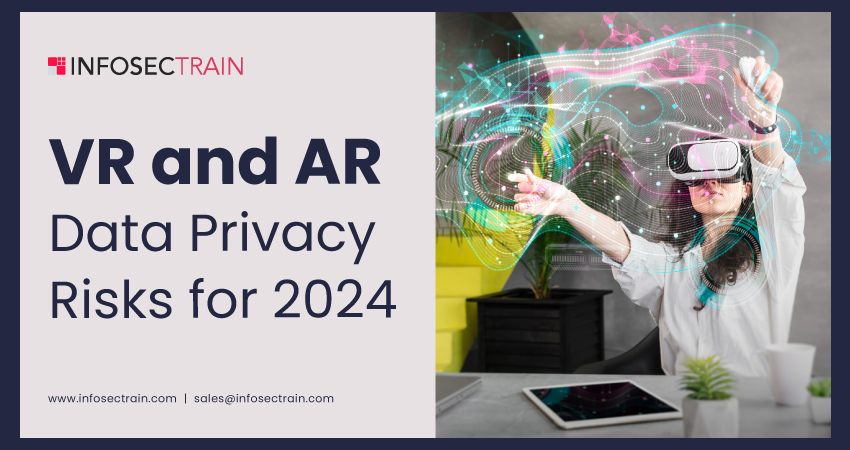VR and AR: Data Privacy Risks for 2024
In the dynamic realms of virtual and augmented reality (VR and AR), the thrilling assurances of immersive experiences coexist with a growing apprehension: data privacy. As we delve further into the immersive landscapes of VR and AR, the need for a solid and adaptable stance on data privacy amplifies. Embracing the full potential of these transformative technologies without compromising the sanctity of our digital identities requires a collective dedication to transparency, security, and policies centred around users.

Table of Contents
What is Virtual Reality (VR)?
Applications of Virtual Reality (VR)
What is Augmented Reality (AR)?
Applications of Augmented Reality (AR)
Data Privacy Risks Associated with VR and AR
What is Virtual Reality (VR)?
Virtual Reality (VR) provides users with a simulated experience that resembles or entirely differs from the real world. Users can explore virtual worlds, interact with virtual objects, and encounter experiences beyond the confines of reality. The most common method for experiencing VR involves using VR headsets. These headsets generate a stereoscopic image, immersing users in the virtual world. They also monitor head movements, allowing users to look around their virtual surroundings naturally.
Applications of Virtual Reality (VR)
1. Gaming: In VR gaming, users actively participate, immersing themselves in the virtual environment. The technology allows for heightened interaction with game elements, providing a more immersive and realistic gaming experience. Users can navigate and engage with the virtual world using natural movements, enhancing the gaming encounter’s enjoyment and realism.
2. Entertainment: VR takes center stage in entertainment, offering immersive experiences like concerts and movies. Users actively engage with the content, entering a new dimension of enjoyment where the boundaries between reality and the virtual world blur. This transformative technology elevates entertainment by providing users with a unique and captivating experience.
3. Education: In education, VR takes on a transformative role, actively revolutionizing the learning process. Through interactive experiences such as virtual field trips and laboratory simulations, students become active participants in their education, immersed in dynamic environments. This involved engagement enhances the educational experience, making learning more vivid and experiential.
4. Therapy: In the therapeutic field, VR takes an active role in treating conditions such as phobias and pain. Through immersive experiences, individuals actively engage in therapeutic interventions, showcasing the versatility of VR as a tool for enhancing mental and physical well-being. This active therapeutic approach signifies a dynamic shift in utilizing technology for comprehensive health solutions.
5. Training: In training, VR emerges as a potent tool for actively preparing individuals for diverse tasks, including surgery and flying. Through immersive simulations, users engage actively in learning, honing their skills in a realistic and controlled virtual environment. This active training approach proves instrumental in developing proficiency and competence for complex tasks.
What is Augmented Reality (AR)?
In Augmented Reality (AR), computer-generated information enhances real-world environments, engaging multiple senses. Users experience constructive additions or destructive overlays, creating an immersive blend with the physical world. This integration actively alters users’ perception of their surroundings, distinguishing AR from virtual reality, which entirely replaces the real world. Augmented reality connects with terms like mixed reality and computer-mediated reality, highlighting its dynamic relationship with evolving technologies.
Applications of Augmented Reality (AR)
1. Gaming: In augmented reality (AR) gaming, virtual objects are actively superimposed onto the real world, offering an interactive and dynamic gaming experience. This active overlay enhances gameplay by integrating digital elements with the user’s immediate physical environment, blurring the lines between the virtual and real worlds. Players engage with a unique blend of reality and fantasy, making AR gaming an immersive and interactive form of entertainment.
2. Manufacturing: Augmented Reality (AR) plays an active role in manufacturing by delivering instructions and real-time feedback to workers. This application improves efficiency and accuracy on the factory floor, ensuring employees receive guidance and updates as they carry out their tasks. The integration of AR in manufacturing contributes to a more streamlined and effective production process, demonstrating its active impact on modern industrial practices.
3. Retail: In the retail industry, Augmented Reality (AR) is active by allowing users to preview products in their homes or virtually try on clothes and makeup. This functional integration enhances the shopping experience, providing consumers with immersive digital interactions that bridge the gap between online and in-store experiences. AR actively transforms how customers engage with products, offering a dynamic and personalized approach to virtual shopping.
4. Navigation: In navigation, Augmented Reality (AR) is active through apps that provide directions and information directly in the user’s field of view. This functional integration enhances real-time guidance, offering users a more intuitive and immersive navigation experience. AR transforms how individuals navigate their surroundings by overlaying digital information onto the physical world, improving the efficiency and convenience of navigation applications.
5. Education: In education, Augmented Reality (AR) plays an active role by creating interactive learning experiences. This includes virtual dissections and historical simulations that engage students dynamically and immerse them in the subject. AR actively transforms the educational landscape by providing a hands-on and immersive approach, enhancing how students interact with and absorb information.
Data Privacy Risks Associated with VR and AR:
1. Collection of Personal Data:
In virtual and augmented reality, VR headsets, AR glasses, smart cameras, and related devices play an active role in collecting an extensive array of personal data, including details like head movements, eye movements, facial expressions, and voice recordings. This involved data collection that tracked users’ movements, discerning their emotions, and even making inferences about their thoughts. The active nature of this data gathering raises essential considerations about privacy and user consent in the context of VR and AR technologies.
2. Lack of Transparency and Control:
In virtual and augmented reality, users actively need help with the limited transparency and control mechanisms regarding the collection and utilization of their data. This lack of clarity and authority makes it difficult for users to actively protect and manage their privacy within VR and AR systems, highlighting the importance of addressing transparency and control issues in developing and using these technologies.
3. Security Vulnerabilities:
VR headsets, AR glasses, and related devices are susceptible to security vulnerabilities in virtual and augmented reality. This vulnerability exposes them to potential threats, as attackers could actively exploit these weaknesses to steal personal data, gain control of the device, or launch cyberattacks against other devices connected to the network. Addressing and mitigating these security concerns is crucial for ensuring the integrity and safety of VR and AR technologies.
4. Use of Personal Data for Targeted Advertising:
In virtual and augmented reality, companies actively utilize the personal data collected for targeted advertising, customizing promotional content according to users’ specific interests and preferences. Although this strategy proves to be highly effective in engaging users, it concurrently sparks concerns regarding privacy and surveillance. Striking a balance between personalized advertising and user privacy becomes imperative in navigating the ethical landscape of VR and AR technologies.
5. Sale of Personal Data to Third Parties:
In virtual and augmented reality, companies actively sell the personal data they accumulate to third parties. This practice enables the utilization of such information for diverse purposes, ranging from marketing and research to credit scoring. The active involvement in data commerce raises significant considerations about user privacy and the ethical handling of personal information within the VR and AR ecosystem.
How can InfosecTrain Help?
InfosecTrain empowers individuals to become data privacy professionals through various training courses, including Certified Data Privacy Professional (CDPP), GDPR, and IAPP certifications. These courses provide comprehensive insights into data protection laws, regulations, and practices, covering key aspects such as data protection policies, risk assessment, privacy by design, data breach response, and privacy-enhancing technologies. By incorporating hands-on experience and real-world case studies, these courses actively equip individuals with the skills and knowledge essential for excelling in the dynamic and evolving field of data privacy, which demands expertise in technology and privacy laws.




 1800-843-7890 (India)
1800-843-7890 (India) 
